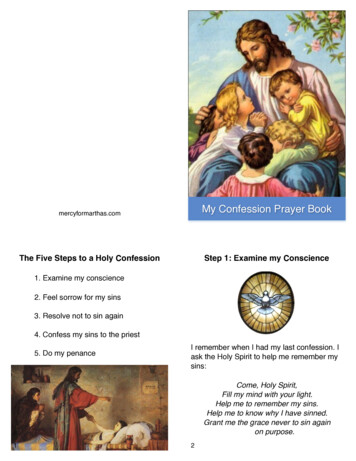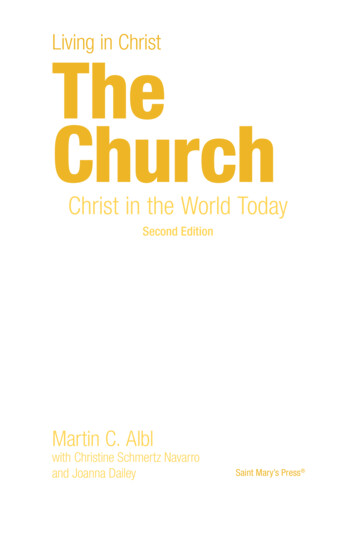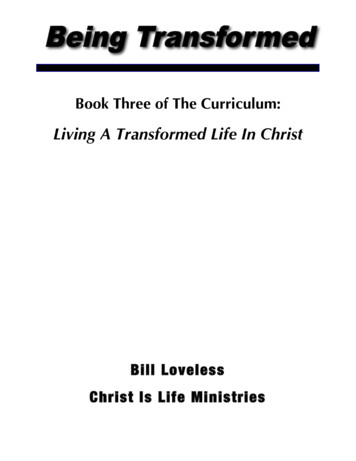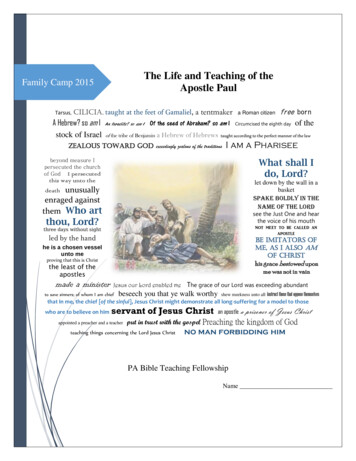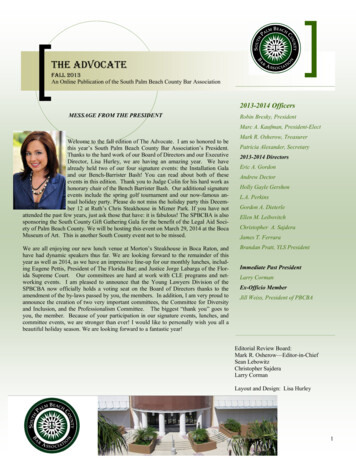
Transcription
Inside this Issue. The Three Offices of Christ The Whole Bible in One Meal What is Jesus’ Evangelism Program? Jesus the Divine Word
Page 2
From Alpha to Omega: A Portrait of JesusPage 3
Page 4Table of Contents Editor’s CornerPage 6By Dave Jenkins To Focus on Jesus and His Resurrection,Spotlight the BibleBy David Prince Page 11Biblical and Historical Evidence for theTriumphant Resurrection of ChristBy Dave Jenkins Page 8“But Now” — Learning to Live in theNewness of ChristPage 17By David Schrock Reigning with Christ on Daily MissionPage 21By Jason M. Garwood Captivated: Beholding the Mystery of Jesus’Death and Resurrection(A Book Review)By Dave Jenkins Three Critical Truths About RedemptionBy Brian HedgesPage 24Page 26Page 30 Five Truths About the Resurrection ofJesusBy Joseph Schuemann Three Critical Historical Evidences for theResurrection of ChristBy Matt PermanPage 32 The Three Offices of ChristPage 41By Matt AdamsPage 44 Jesus the Divine WordBy Dave Jenkins Three Critical Truths About PropitiationBy Chris PobletePage 47 Understanding Gospel JustificationBy Matt PermanPage 49 How to Deal with Guilt, Condemnation,and Shame with the GospelBy Chris PobletePage 54
From Alpha to Omega: A Portrait of JesusPage 5Table of Contents Continued. Christ Our Substitute: The Meaning of theCrossBy Thaddeus WIlliams The Incarnation: Jesus Fully God and FullyManPage 58Page 60By Dave Jenkins What is the Doctrine of JustificationBy Matt PermanPage 67 Why Justification by Faith Alone isNecessary for Good WorksBy Matt PermanPage 70 Six Things Christ Accomplished by HisDeathBy Matt Perman A Brief Word on the Gospel and the OldTestamentBy Charlie Handren Meeting Jesus at an Old Testament FeastBy John SittemaPage 77 The Whole Bible in One MealBy John FlamePage 79 The Old Testament: Written to and AboutJesusBy Nick Batzig The Lamb of God: Worship and the HighPriestly Ministry of JesusBy Dave Jenkins The Incarnation and the High PriestlyMinistry of JesusBy Dave Jenkins What is Jesus’ Evangelism Program?By David Schrock Recommended Reading on the Person andWork of JesusBy Dave Jenkins About the AuthorsPage 72Page 75Page 81Page 85Page 87Page 90Page 93Page 94
Page 6Editor’s CornerEXECUTIVE EDITORDave JenkinsMANAGING EDITORSarah JenkinsDESIGN DIRECTORSarah JenkinsADVERTISINGTo advertise in Theology for Life Magazine, emaildave@servantsofgrace.orgCOPYRIGHT Theology for LifeMagazine grantspermission for anyoriginal article to bequoted, providedTheology for Life iscited as the source.For use of an entirearticle, permissionmust be granted.Please contactdave@servantsofgrace.org.The resurrection of Jesus is critical to a solid understanding of thegospel. When talking about the doctrine of salvation, what is often emphasized in the contemporary evangelical literature is the death of Jesusand the benefits therein. What’s often missing is the resurrection of Jesus.When we look at the Gospels, though, we see Jesus talking about theresurrection. When we look at the rest of the New Testament, we discover the Apostles talking about the resurrection. Now, the death of Jesus iscentral to the gospel, make no mistake about it. But the death of Jesus isonly one-third of the gospel. The other two-thirds of the gospel are theburial, and resurrection of Jesus. To be clear, I’m not only saying that thedeath, burial, and resurrection of Jesus is all the gospel is—there is moreto the work of Jesus than just the death, burial, and resurrection of Jesus.The resurrection of Jesus is just as critical to an accurate gospel messageas is the death and burial of our Lord Jesus. Not only is the death, burial,and resurrection of Jesus essential, so is the ascension of Jesus, His ongoing ministry as our High Priest/ Intercessor/ Mediator, and His soon return at His Second Coming.In John 11:25-26, Jesus says to Martha, “I am the resurrection andthe life. Whoever believes in me, though he die, yet shall he live, andeveryone who lives and believes in me shall never die. Do you believethis?” These words of Jesus in John 11:25 are among the most precious andimportant words to ever fall from His lips. J.C. Ryle comments that Jesus“tells Martha that He is not merely a human teacher of the resurrection,but the Divine Author of all resurrection, whether spiritual or physicaland the Root and Foundation of all life.”Jesus reveals Himself as the source of “the resurrection and thelife”. We can hope in the resurrection because Jesus Himself has enteredinto death and risen from the grave. “The whole human race is plungedin death,” writes John Calvin. “Therefore, no man will possess life unlesshe is first risen from the dead. Hence Christ teaches that He is the beginning of life.”“In him was life,” John said in chapter 1 of his Gospel testimony,“and the life was the light of men” (verse 4). Therefore, “All who face therecurrent death situations of life and wrestle with questions of deathand life can find an answer only through faith in him.” To believe in Jesus is to receive the benefit not only of His life and death, but also of Hisresurrection; from Him through faith, Christians are entered into glorythrough the light of His open tomb. “Because I live,” Jesus said, “you alsowill live” (John 14:19).If the resurrection’s beginning and source rests with Jesus Himself—with His divine person and saving work—then the middle ofChrist’s resurrection promise deals with His answer to death: “Whoeverbelieves in me, though he die, yet shall he live” (John 11:25). Here is theanswer—the only real answer—to the problem of death. By trusting in
From Alpha to Omega: A Portrait of JesusPage 7Jesus, we gain the promise of resurrection life.To believe in Jesus is to start living the resurrection life even now. We do not have to wait untilwe die to receive new life from Christ; His resurrection begins in us the moment we believe. This wasPaul’s point in Ephesians 1:2 and 4-5—namely that the gift of God offers to anyone who will come infaith to Jesus. Those who believe in Jesus are freed from the power of death, even before they die, andthey receive His never-ending life even now, to live in this world as those who have everything to gainand nothing to lose.Whether you have questions about the death of Jesus or the resurrection of Jesus, in this issueof Theology for Life Magazine we are exploring these issues to help skeptics understand the heartbeatof the Christian faith. Also, we’re aiming to help Christians grow in knowledge and confidence in thegospel message so they will share it with others all around them.Wherever you are on the spectrum regarding the death and resurrection of Jesus, all of historyrevolves around Jesus. Jesus is the only Lord and Savior who can save. All other greats of world historyhave gone and are buried in the grave. Only Jesus rose again from the grave. Only Jesus can granteternal life to those who believe in Him. All the philosophies and philosophers, along with the religionsof the world, fail to offer what the biblical gospel delivers on—namely eternal life.We encourage you to dive into this issue of Theology for Life and read it carefully, thoughtfully. No doubt, you’ll have further questions about these issues, which is why—at the end of this issue—we’ve provided recommended reading for your thoughtful and prayerful consideration. Take up andread, and learn about our great God in Jesus Christ, who came as a baby—although under the sentence of death for man’s sin—and lived a sinless life, died in the place and for sinners, was buried, androse again. This Lord is coming back for His own to judge, rule, and to fully establish His Kingdom forthe praise of His name and the joy of His Beloved.In Christ Alone,Dave JenkinsExecutive Editor, Theology for Life MagazineReferences:J.C. Ryle, Expository Thoughts on the Gospels: John, 3 vols. (Edinburg: Banner of Truth, 1999),2:297.ii. John Calvin, New Testament Commentaries, trans. T.H.L. Parker, 12 Vols (Grand Rapids: Eerdmans, 1959), 5:8.iii. Herman Ridderbos, John: A Theological Commentary (Grand Rapids: Zondervan, 1997), 396.i.
Page 8To Focus on Jesus and HisResurrection, Spotlight the BibleBy David PrinceDo not believe anyone who tells you that the way to focus on Jesus andHis resurrection is to take the spotlight off the Bible. The entire Bible is a blessing tothe believer, not a burden. It is not an obstacle to effective evangelism; it is our divinely authoritativesource of gospel truth. The Spirit that raised Jesus from the grave is the same Spirit that inspired theHoly Scriptures (Luke 16:19-31, Romans 8:11, 2nd Peter 1:16-21).Scripture is not only the product of human authors but is also, and ultimately, the product ofthe Divine Author, representing God’s self-revelation to humanity. Scripture is the very word of God
From Alpha to Omega: A Portrait of JesusPage 9addressed to human beings. What the Bible says, God says. The Bible possesses a divine unity as itprogressively unfolds redemptive history, which points toward Jesus Christ, the one in whom all of thepromises of God are “Yes” and “Amen” (2nd Corinthians 1:20).Moreover, “the analogy of Scripture” (Scripture interprets Scripture) is a principle that Scriptureitself commends to interpreters, not some foreign notion imposed on the text. The analogy of Scripturesimply reminds the interpreter that the Word of God is infallibly auto-interpreting. “All Scripture isbreathed out by God”, and the God who gives His Word is also the interpreter of His Word (1st Timothy3:16). Understanding, and rightly trusting in the historical acts of God, is dependent on the Scripturalwitness that provides us with the meaning of those acts. The outward events of Jesus’ life and ministrytook place that the Scripture might be fulfilled. The Bible answers the question, “Which Jesus? Whatresurrection?”The risen Jesus’ method to convince His disciples that He was resurrected and that the Messianic promise of redemption and kingdom remainedwas to exegete the Old Testament Scripture (Luke24:27). He did this rather than providing some newsign or vision. The fact of Jesus of Nazareth’s resurrec“In Paul’s lengthy chapter on the resurrection oftion does not answer the question of meaning apartfrom the biblical witness that it was the resurrection of Christ, he begins by tying the fact of the resurrectionthe promised Messiah (Luke 24:44). In light of Jesus’to the Scriptures.”approach and teaching, it is clear that Scripture musthave a vital place in the life of the believing communityin order for it to faithfully focus on Jesus. It must be apriority to properly interpret and proclaim the Scripture to the Church and to the world so that we cancommunicate the meaning of Jesus’ life, death, and resurrection.Paul follows Jesus’ example and focuses on the resurrection of Jesus byputting the spotlight on the Bible. Paul, preaching in Thessalonica, followed the pattern ofJesus before him: “As was his custom, and on three Sabbath days he reasoned with them from theScriptures, explaining and proving that it was necessary for the Christ to suffer and to rise from thedead, and saying, ‘This Jesus, whom I proclaim to you, is the Christ’” (Acts 17:2-3). Before Agrippa,Paul was “saying nothing but what the prophets and Moses said would come to pass: that the Christmust suffer and that, by being the first to rise from the dead, he would proclaim light both to our people and to the Gentiles” (Acts 26:22b-23).In Paul’s lengthy chapter on the resurrection of Christ, he begins by tying the fact of the resurrection to the Scriptures: “For I delivered to you as of first importance what I also received: that Christdied for our sins in accordance with the Scriptures, that he was buried, that he was raised on the thirdday in accordance with the Scriptures” (1st Corinthians 15:3-4). Jesus’ acts were rooted in a deliberateword-fulfillment of the biblical testimony about the Messiah. He came to fulfill the law (Matthew 5:17).The Scriptures testify of Him (John 5:39). The Scriptures cannot be broken (John 10:35). Fulfilling theScriptures was Jesus’ vocation as Messiah. To take the focus off of the Bible is to take the focus off ofthe meaning of Jesus the Messiah and His resurrection.The biblical text must not be ignored or abused in preaching. We are to preach Christ from theentire Bible, because proper exegesis demands it. Jesus holds Himself up as the key to understandingthe Scripture (John 5:46). The written word, the inscripturated Logos, is not just the message about
Page 10Christ; it is also the ministry of Christ. He is present and active in the truth of His Word. He is the incarnate Word who comes to us in the inspired Word. To faithfully explain the living Word is to rightlyproclaim the written Word. They can be conceptually separated, but they function as one unified fountof authority. Christ comes to us and is present to us in preaching that is true to His Word (Romans10:14-16).The Bible is the written Word of God. Jesus is the definitive Word of God. Faithful preaching inevery era centers on the definitive Word of God, Jesus, as revealed in the authoritative written Word ofGod, the Scripture. The diverse genres and epochs of the biblical witness cohere around the story of thekingdom of Christ. Faithful preaching proceeds theologically with awareness that the entire biblicalstoryline finds its meaning and culmination in God’s final word, Jesus. The gospel is the hermeneuticalkey and the theological center of the entire Bible.Any attempt to sever Jesus from the Scripture, or vice versa, is a fool’s errand. To minimize either is to distort the other inevitably. There is a world of difference in suggesting that Jesus is the only thing in the Bible that fundamentally matters and believingthat because of Jesus everything in the Bible matters. The first is a path to apostasy, and the latter isthe ground of our hope now and forever. Like John, we are those who bear “witness to the word of Godand to the testimony of Jesus Christ” (Revelation 1:2).
From Alpha to Omega: A Portrait of JesusPage 11Biblical and Historical Evidence forthe Triumphant Resurrection ofChristBy Dave JenkinsJesus in John 11:25 said, “I am, the resurrection and the life. Whoeverbelieves in me, though he die, yet shall he live.” The lengthiest explanation of Jesus’resurrection is found in 1st Corinthians 15. This whole chapter is about how if Jesus did not bodilyrise in victory over death, then Christianity is false and dreamed up by liars to give false hope to people. In this article, we will examine the biblical evidence, historical evidence, and arguments againstthe resurrection.The resurrection of Christ is the most known and celebrated miracle in the history of theworld. There has always been consensus that it is in many ways the core of our faith:Thomas Arnold (Professor of Modern History at Oxford) said, “No one fact in the history of mankind isproved by better and fuller evidence of every sort [than the fact that] Christ died and rose from the
Page 12dead.”Bishop B.F. Westcott stated: “Indeed, taking all the evidences together it is not too much to saythat there is no historical incident better or more variously supported than the resurrection of Christ.”John Locke said, “Our Savior’s resurrection is truly of great importance in Christianity; so greatthat His being or not being the Messiah still stands or falls with it.”Billy Graham explains: “The entire plan for the future has its key in the resurrection.”Martin Luther assures: “Our Lord has written the promise of the resurrection not in wordsalone, but in every leaf in springtime.”John R. Stott notes: “Christianity is in its very essence a resurrection religion. The concept ofresurrection lies at its heart. If you remove it, Christianity is destroyed.”William Lyon Phelps (Yale Professor) instructs: “In the whole story of Jesus Christ, the most important event is the resurrection.”Benjamin Warfield (Princeton Professor) exclaims: “The resurrection of Christ is a fact.” Havingtaken a look at what some people have said regarding the resurrection let us now turn to the Biblicalevidence for the Resurrection of Christ.Rooted in History700 years before the birth of Jesus, the prophet Isaiah promised that Jesus would be born intohumble circumstances, to live a simple life, die a brutal death, and then rise to take away our sin(Isaiah 53:8-12). On numerous occasions, Jesus himselfplainly promised He would die and rise three days later(Matthew 12:38-40; Mark 8:31; John 2:18-22).The death of Christ was a brutal event where He un“Jesus was a very poor man who could not affordderwent sleepless nights of trial and beating that left Himan expensive burial plot.”exhausted. He was scourged with a whip, crucified on across, and had a spear thrust in His side. Later He waswrapped in roughly one hundred pounds of linens and spices, which would have killed Him by asphyxiation, were Hestill alive. Through this all Jesus could have survived, but He could not have endured three days without food and water in a cold tomb carved out of rock with all of His previous treatments piled on. (John19:34-35). Jesus was dead before they’d wrapped him in the linens for burial.Jesus Was Buried in a Tomb That Was Easy to FindJesus was a very poor man who could not afford an expensive burial plot. After He died on thecross, a wealthy and well-known man named Joseph of Arimathea gifted his expensive tomb for theburial of Jesus. This made the tomb easy to find, as soldiers were assigned to guard it. The disciplesand women who visited the tomb and found it empty all knew exactly where Jesus’ dead body had beenlaid to rest. Had Jesus not risen from death, it would have been easy to prove it by opening the tomband presenting Jesus’ body as evidence. (Isaiah 53:9, Matthew 27:57-30)Jesus Appeared Physically Alive Three Days After His DeathThe Jehovah’s Witnesses reject the physical resurrection of Jesus while maintaining that He rosespiritually. This alternative explanation for Jesus’ resurrection does not agree with the historical facts.Following Jesus’ resurrection, many people touched His body; His disciples clung to His feet, Maryclung to Him, and Thomas (the doubter) put his hand into the open spear hole in Jesus side. Jesus appeared to His disciples after the resurrection, who had been uncertain if He had truly physically risenfrom death. The Scriptures are clear however that Jesus went out of His way to prove His bodily resur-
From Alpha to Omega: A Portrait of JesusPage 13rection (Matthew 28:9; John 20:17, John 20:17; John 20:20-28). There is no credible historical evidence from the time period of Jesus to validate any alternative explanation for Jesus’ resurrection,other than His literal physical resurrection (Luke 24:36-43).Jesus’ Resurrection Was Recorded as Scripture Shortly After it OccurredMark’s Gospel account of the days leading up to Jesus’ crucifixion mentions the high priestwithout naming him. Mark did not mention the high priest by name because he expected his readersto know whom he was speaking about. Caiaphas was high priest from 18-37 A.D.; the latest possibledate for this tradition is 37 A.D. This date is so close to the death of Jesus there would not have beensufficient time for a legend of His resurrection to occur. This proves that the biblical record of Jesus’resurrection was penned while eyewitnesses were still alive to verify the facts. His resurrection was nota legend that was developed after the time of Jesus (Mark 14:53-54).Jesus’ Resurrection was Celebrated in the Earliest Church Creeds1st Corinthians 15:3-4 states, “Christ died for our sins in accordance with the Scriptures, thathe was buried, that he was raised on the third day in accordance with the Scriptures.” This statementis accepted as the earliest church creed which began circulating as early as 30-36 A.D., shortly afterJesus’ resurrection. The early age of this creed demonstrates there was not sufficient time between thecrucifixion and the creed for any legend about Jesus’ resurrection to accrue. Also, the witnesses mentioned were still alive and available to be questioned about the facts surrounding the resurrection. Theearly date of this creed also proves that the church did not corrupt the truth about Jesus with fablesand folklore like the resurrection. Rather, the early church simply clung to the plain and incontrovertible facts of Jesus’ death, burial, and resurrection.Jesus’ Resurrection Convinced His Family to Worship Him as GodJames, Jesus’ half-brother, was originally opposed to the claims of his brother. A transformation occurred in James after he saw his brother resurrected from death. James went on to pastorthe church in Jerusalem and authored the New Testamentepistle bearing his name. He was also actively involved inshaping the early church, which suffered and died to pro“Paul was a devout Jewish Pharisee who routinely claim to everyone that Jesus is the one true God. Jesus’mother, Mary, was part of the early church that prayed topersecuted and killed Christians.”and worshiped her Son as God, as was Jesus’ other brother,Jude, who wrote a book of the New Testament bearing hisname. While it is not impossible to imagine Jesus convincing his own mother and brothers to suffer persecution inthis life and risk the torments of Hell in eternal life for worshiping Him as the one true God unless Hetruly is (John 7:5; 1st Corinthians 15:7; James 1:1; Acts 12:17; Galatians 2:9; Acts 1:14; Jude 1).Jesus’ Resurrection was Confirmed by His Most Bitter Enemies Like PaulPaul was a devout Jewish Pharisee who routinely persecuted and killed Christians. After anencounter with the risen Christ, Paul was converted and became the most dynamic defender and expander of the Church. Had Jesus not truly risen from death, it is absurd to assume that Paul wouldever have worshiped Him as God, particularly when Paul rightly believed that worshiping a false Godwould send one into Hell. Paul hated Jesus and would never have changed his religious practice unless Jesus had risen from the dead to prove him wrong. Finally, Paul insisted that Jesus had risen inalmost all of his letters that are in the New Testament. (Philippians 3:4-6; Acts 7:54-60; Acts 9).
Page 14Historical Evidence for Jesus’ Death and ResurrectionAfter studying the biblical evidence for Jesus’ resurrection, it is now important to examine thehistorical evidence for His life, death, and resurrection. The historical evidence for Christ’s resurrection is overwhelming. The testimony of these non-Christians is important because it confirms thetruthfulness of the biblical accounts of Jesus. The argument from many non-Christians is there nohistorical evidence to substantiate the Resurrection. Not only is this charge false, it dismisses the evidence without even considering it, which is to violate the principles of sound research in order to justify one’s opinion. Let the historical evidence presented here speak for itself and realize this is only asampling of the massive historical evidence for the resurrection of Christ.Josephus (37-100 A.D.)In the Testimonium Flavianum, Josephus says: “Now there was about this Jesus, a wise man,if it be lawful to call him a man; for he was a doer of wonderful works, a teacher of such men as receive the truth with pleasure. He drew over to him both many of the Jews and many of the Gentiles.He was the Christ. And when Pilate, at the suggestion of the principal men among us, had condemned him to the cross, those that loved him at first did not forsake him; for he appeared to themalive again the third day, as the divine prophets had foretold these men and ten thousand other wonderful things concerning him. And the tribe of Christians, so named from him, are not extinct at thisday.”Suetonius (70-160 A.D.)Suetonius was a Roman historian and annalist of the Imperial House. In his biography of Nero, Suetonius mentions the persecution of Christians by indirectly referring to the resurrection:“Punishment was inflicted on the Christians, a class of men given to a new and mischievous superstition [the resurrection].”Pliny the Younger (62-113 A.D.)Pliny the Younger wrote a letter to Emperor Trajan describing early Christian worship gatherings that met early on Sunday mornings in memory of Jesus’ resurrection day: “I have never beenpresent at an examination of Christians. Consequently, I do not know the nature of the extent of thepunishments usually meted out to them, nor the grounds for starting an investigation and how are itshould be pressed. They also declared that the sum total of their guilt or error accounted to no morethan this: they had met regularly before dawn on a fixed day [Sunday in remembrance of Jesus’ resurrection] to change verses alternately amongst themselves in honor of Christ as if to a god.”Christ Compared to Other “gods”Wilbur M. Smith, in Therefore Stand, states, “The original accounts of Buddha never ascribe tohim any such thing as a resurrection; in fact, in the earliest accounts of his death, namely, the Mahaparinibbana Sutta, we read that when Buddha died it was ‘with that utter passing away in whichnothing whatever remains behind.”Professor Childers says, “There is no trace in the Pali scriptures or commentaries (or so far asI know in any Pali book) Sakya Muni having existed after his death or appearing to his disciples. Mohammed died June 8th, 632 A.D., at the age of sixty-one, at Medina, where his tomb is annually visited by thousands of devout Mohammedans [Islams]. All the millions and millions of Jews, Buddhists,and Mohammedans agree that their founders have never come up out of the dust of the earth in resurrection.”Theodosus Harnock exclaims: “Where you stand with regard to the fact of the Resurrection isin my eyes no longer Christian theology. To me, Christianity stands or falls with the Resurrection.”
From Alpha to Omega: A Portrait of JesusPage 15Professor William Milligan advises: “While speaking of the positive evidence for the Resurrectionof our Lord, it may be further urged that the fact, if true, harmonizes all the other facts of His history.”Bernard Ramm says, “[That even] the most cursory reading of the Gospels reveals the fact thatthe Gospels deal with the death and resurrection of Christ in far greater detail than any other part ofthe ministry of Christ. The details of the resurrection must not be artificially severed from the passionaccount.”Many impartial students who have approached the resurrection of Christ with a judicial spirithave been compelled by the weight of the evidence to belief in the resurrection as a fact of history. Anexample may be seen from a letter written by Sir Edward Clarke, K.C., to Reverend E. L. Macassey:As a lawyer, I have made a prolonged study of the evidences for the events of the first EasterDay. To me the evidence is conclusive, and over and over again in the High Court, I have securedthe verdict on evidence not nearly so compelling. Inference follows on evidence, and a truthful witness is always artless and disdains effect. The Gospel evidence for the resurrection is of thisclass, and as a lawyer, I accept it unreservedly as the testimony of truthful men to facts theywere able to substantiate.Professor Bernard Ramm also comments, “In both ecclesiastical history and creedal history theresurrection is affirmed from the earliest times. It is mentioned in Clement of Rome, Epistle to the Corinthians (95 A.D.), the earliest document of church history and so continuously throughout all thepatristic period. It appears in all forms of the Apostles’ Creed and is never debated.”The Jewish ExplanationThe earliest attempt to provide an alternative explanation for the resurrection of Christ did notdeny that tomb was empty (Matthew 28:13-15). The Jews claimed that the body was stolen, thus admitting the fact of the empty tomb. The tomb was closed with an enormous rock and sealed by the government, and there is no explanation for how the rock was moved while being guarded by Roman soldiers. Second, if the body had been stolen, a large ransom could have been offered to the thieves, andthey could have been coerced to produce the body. If the disciples had taken the body, then the onlything the Jews would have had to do is to persecute the disciples enough to give up the body of Jesus.Thirdly, if the body was stolen, how are we to account for the fact that Jesus appeared to multiplecrowds of people, proving that He was alive. Finally, the theft of the body is unlikely and still fails toaccount for it returning to life.In Summary The historical testimony of those who were not Christians stands in agreement with the Scripture that Jesus died and rose again, because those are facts established from the Bible and history.Having examined the biblical, historical, and some of the arguments against the resurrection, it isclear that the resurrection of Christ is a historical and biblical fact.Every year Christians celebrate the resurrection of Jesus at Easter. Many people believe in thehistorical fact of Jesus’ resurrection but have not become Christians by placing their personal faith inHim. Jesus promised that He would not only rise from death to prove beyond any shadow of a doubtthat He is God, but also that He would judge everyone who has ever lived and determine their faith(John 5:16-30). His first promise came true when He rose from death, and His second promise willcome true either upon our death or upon His return. The opportunity in this life is to repent and turnfrom sin only extends in this life. There are no second chances after death to repent. Jesus is morethan just a good man, teacher, prophet, and priest; He is the Son of God, who died for sinners, wasburied, and rose again. Forgiveness and eternal life are made possible only through Jesus’ own death
Page 16and resurrection for humanity.The burial and resurrection of Christ form two-thirds of the Gospel. Th
Resurrection, Spotlight the Bible By David Prince Do not believe anyone who tells you that the way to focus on Jesus and His resurrection is to take the spotlight off the Bible. The entire Bible is a blessing to the believer, not a burden. It is not an obstacle to effective evangelism; it is our divinely authoritative source of gospel truth.


